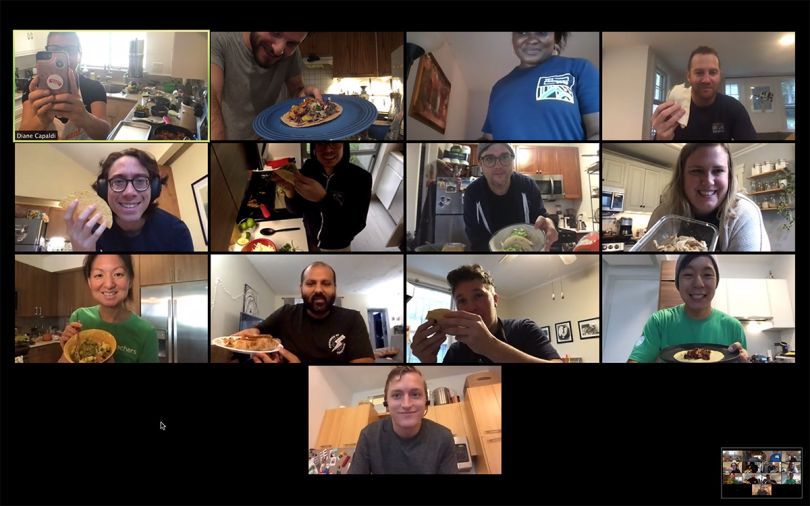Employees at Teachers Pay Teachers, also known as TpT, come to work each day motivated to solve the issues that educators face, building out a full-service digital platform that empowers them to teach at their best. As the TpT team made the transition to a hybrid work environment, two of the company’s seven core values — “learning and growing together” and “enjoying the journey” — became crucial guiding forces.
Over the past couple of years, the team behind the teacher-powered learning platform has been focused on acclimating to a new way of working — and connecting with each other. Having embraced a hybrid model, the company put careful thought into cultivating a culture that caters to both in-office and remote employees.
According to Megan Timpf, TpT’s first employee experience specialist, building an inclusive hybrid environment enables team members to experiment with different bonding opportunities and have more fun. It’s also crucial for fostering a workplace rooted in collaboration, continual iteration and trust.
“As we relate to each other on a more personal level, our collaboration and shared sense of respect will increase even more,” Timpf said.
For Sales Development Representative Alfonso Corona, who works remotely in California, being employed by a company that believes in its people is especially important. “Having that flexibility and empowerment is something I hadn’t experienced in a workplace before joining TpT,” he said.
SUPPORT THROUGH UNCERTAINTY
Timpf added that this focus on empowerment is reflected across the organization, including its regular opportunities for career growth. Professional development is a major focus at the company and is an ongoing process guided by leaders across the organization.
“Managers are encouraged to discuss growth with their direct reports regularly, and when there are roles to fill, we make an effort to look at our existing employees and help them scale their career paths,” Timpf said.
According to Nathan Lehmann-Ziebarth, whose role as senior manager of growth marketing includes supporting and enabling the success of TpT’s growing sales team, the company’s distributed workforce model is both positive for company culture and effective from a business perspective. Having sales professionals located across the country enables the organization to understand and address many different educators’ unique pain points.
“In that sense, having reps in various regions allows us to build lasting relationships,” Lehmann-Ziebarth said.
As TpT continues to expand, the team is ready to welcome the next wave of new hires into its inclusive and inspiring workplace, where they’ll have the opportunity to drive change within a crucial industry. Below, Timpf, Corona and Lehmann-Ziebarth describe how the company enables both in-office and remote employees to forge relationships, grow their careers and make an impact on educators.

Tell me about the company’s remote onboarding process. How do team members have opportunities to connect throughout it?
Timpf: The people operations team handles our two-week onboarding program. New hires meet for a virtual lunch with several leaders, including our CEO. We also have a buddy program, which pairs each new hire with someone they will work with either directly or adjacently. We create a Slack channel for each cohort of new hires, which gives them space to ask questions and keep in close contact with each other.
Lehmann-Ziebarth: On the sales team, we focus on implementing synchronous moments throughout the onboarding process. Because we’re growing so quickly and onboarding multiple reps at once, we strive to cultivate culture within each onboarding class. This allows us to integrate small subcultures into the larger sales environment. Once they’ve gone through onboarding, we introduce each class of new hires to the rest of the sales team. When the sales team was smaller, we had each new hire take part in one-on-one coffee chats with their peers. With close to 100 people on our team now, this has become more difficult to manage, so we use Donut, which pairs team members up randomly so they can get to know each other.
PASSION DRIVES EMPOWERMENT
Corona: I went through the onboarding process about eight months ago. It was helpful to join the team alongside others with similar questions, while sharing a Slack channel to discuss anything and ask for help if needed. Nathan and others on the team immediately answered any questions we had and ensured we had all the documentation we needed to learn asynchronously. We also do a lot of shadowing work, which helps new hires get a sense of how processes work.
How does a distributed model enable the sales team to understand educators’ unique needs?
Corona: It enables reps to simply listen to their surrounding communities. For instance, if you’re living within a certain city, you’ll know which schools are on a break and will be able to drop that information into a Slack channel so that other reps know why that client may not be responsive. Reps wouldn’t have easy access to this type of information if they were all based in the same city. It also helps reps understand the educational systems in different states, giving them a sense of classroom expectations and standards, which they can then share with the rest of the team.
Lehmann-Ziebarth: The sales team also pays attention to weather patterns, which have a significant impact on schools. It enables us to cultivate empathy and trust when we call schools and speak to administrators who are still going into work in difficult weather. Our reps have also created their own smaller teams within each region. For instance, our team members in Dallas get together frequently and have created their own outpost of the company, even though we don’t have an office there. It’s been exciting to see these hubs grow organically.

How does the company enable both in-office and remote employees to interact and cultivate community?
Timpf: We have employee resource groups dedicated to celebrating different groups of people across the company. Recently, we honored Black History Month and Women’s History Month by offering a variety of programs, such as virtual guest speakers. We also spotlight ERG members to learn more about each other on a personal level. For example, throughout Black History Month, our Black employee resource group ERG, Blackboard, shared weekly fun facts about different group members on our companywide Slack channel, and that really engaged the entire team.
A NONHIERARCHICAL APPROACH
Corona: Employees often acknowledge their peers for doing outstanding work across the company. At some organizations, this type of recognition diminishes over time. Yet I still see consistent shoutouts at the company, especially during companywide meetings. This is a huge factor in driving our culture. We realize we should never stop celebrating each other.
What professional development opportunities are available to employees?
Timpf: I’ve personally grown significantly at the company, having joined the organization as an executive assistant. During one of our biannual performance reviews, I realized I wanted to transition into the people operations team. Eventually, an opportunity arose for me to move to that team, and our CEO fully supported me and helped me prepare for my new role. Additionally, we offer snack and learns, which cover a wide range of topics, from research report readouts to Zoom tutorials. Besides that, we have learning guilds, including one for our engineering team, which hosts weekly “Eng Learning Fridays.” Additionally, we have weekly demos, which enable team members to share what they’ve learned and highlight important projects.
Lehmann-Ziebarth: The company’s sales reps have access to micro-promotions within their given role, as many of them are invested in progression. Our reps progress to different lead lists, which increase in complexity over time. This enables us to create momentum for every team member. We want to pay close attention to career trajectory and make sure we clarify what that looks like for each rep.
Corona: I started having conversations with my manager about career growth during my first week at the company. After a couple of months, I moved on to a different lead list, which enabled me to flex into account executive work. I started training, shadowing demos and taking on work when my peers needed help. After about one month, I fully transitioned into the role I have now. The company has made it easy for me to understand how to move upward within the sales team. My manager makes a point to discuss development every time we meet in addition to hosting a monthly conversation focused solely on career progression. We also have a mentorship program that lasts for about six months and pairs employees up after each review cycle. My mentor isn’t on the sales team, yet he’s helped me gauge long-term career goals and offers insightful advice.

What do you consider the greatest benefit of joining TpT as a remote employee?
Corona: One of our core company values is “we think and act as owners,” and we’re trusted to do that. It’s evident that the company trusts us and gives us space to get our work done. This understanding is also reflected in the fact that employees can take wellness days if needed.
Lehmann-Ziebarth: My manager encourages me to take time off on a monthly basis and ensure my needs and those of my family are being met. It’s important to have a leader invested in that, and being at a company that seems to care about me as a person makes me want to work harder. I’m more willing to put in time to deliver high-quality work.
Timpf: We have been intentional in our efforts to reimagine our workforce as we transition into a new phase of normalcy. We had a couple of working groups, one of which was dedicated to brainstorming best practices and norms for hybrid work. They consider what’s best for employees across different time zones, working parents and anyone else impacted by remote work. As a working parent myself, I appreciate having the flexibility to step away from my computer to pick my son up from daycare.
What’s on the horizon in terms of bolstering the company’s cultural and career development efforts?
Lehmann-Ziebarth: On the training and development side, we just brought on a learning management system. This allows us to deploy training asynchronously for our sales team and will enable us to continue to move forward in lockstep as a team. By creating videos and other personal touch points to build out our asynchronous learning, we’ll be able to foster a human touch in a remote world.
Timpf: We’re continually searching for more ways to create connections between our virtual and in-person events. It’s not easy, but we’re going for it anyway. We’re unafraid to try something new, as long as it creates a more inclusive culture.








